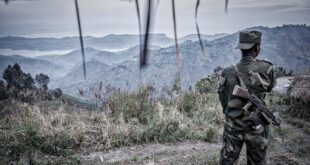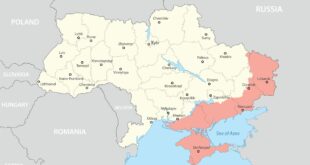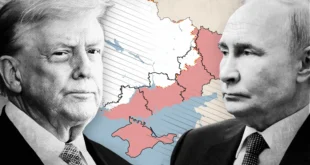
Moscow and Beijing distrust the Kim regime and, with pressing concerns elsewhere, are loath to see DPRK behaviour destabilise the Korean Peninsula.
Manifestly military
The first indication that Kim would visit Russia came via media reports published on 4 September, sourced to unattributed statements from US and allied officials. While some details proved inaccurate, the main thrust – that Kim and Putin would meet to discuss weapons – was correct. Kim left Pyongyang on 10 September in his signature armoured train with a 150-strong entourage. His team and itinerary (see Figure 1) bespoke the trip’s military focus. Covering some 4000km, Kim visited several major aerospace sites in Russia’s Far East.

A more typical leader would have covered the same distance in half the time by flying, and indeed, Kim may have flown some legs. Yet travelling abroad by train fit tradition – his grandfather Kim Il-sung began the practice, and his father Kim Jong-il continued it – and proved media-savvy. For guest and host alike, the trip’s spectacle was deliberate, but its substance was less clear. The summit yielded no joint or individual statements. Informally, Russian officials cited many areas for possible cooperation, mostly non-military, but few details have been released and speculation has thus filled the gap.

Burden of history
After Moscow accepted Washington’s proposal in 1945 to ‘temporarily’ partition the Korean Peninsula to accept Japan’s surrender, Stalin appointed Kim Il-sung, a young guerrilla whom Japanese forces had pushed into Siberia, as a figurehead leader. He arrived in a Red Army uniform. The division soon hardened into a national border between separate states proclaimed in 1948: the Republic of Korea below the 38th parallel and the Democratic People’s Republic of Korea above.
In June 1950, Kim persuaded Stalin and China’s Mao Zedong that he could forcefully reunify Korea. A United Nations Command army led by the US eventually repelled the DPRK advance, and only intervention by China saved North Korea from extinction. Four million people died during the three-year war, which caused immense destruction. North Korea rebuilt and industrialised quickly, mainly with Soviet funding. Kim Il-sung nonetheless refused to join Comecon (the grouping through which Moscow dominated its satellites’ economies), defaulted on Soviet loans, and remained neutral in the Sino-Soviet dispute, receiving aid from both countries. Tellingly, no top Soviet leader ever visited Pyongyang, yet the Soviet Union continued providing military and economic assistance to the country (e.g., exporting MiG-29 fighter aircraft as late as 1989).
In 1990, then-president Mikhail Gorbachev upended the Peninsula’s post-1945 order: the Soviet Union recognised South Korea (receiving a US$3 billion loan from Seoul on which Russia later defaulted). Then, the Soviet Union collapsed and its subsidies abruptly ceased. While some aid recipients – Cuba and Vietnam – adapted, the change proved catastrophic for North Korea. Belying Kim Il-sung’s claims of DPRK self-reliance, or juche, an IMF mission was told that from 1992 to 1996, GDP had declined by 49.2% (from US$20.9bn to US$10.6bn). From 1995 to 1998, famine killed at least 500,000 people.
Bilateral ties have never recovered from these traumas. In 2000, early in Putin’s presidency, he visited Pyongyang. He then hosted North Korea’s Kim Jong-il – whose train trundled all the way to Moscow – in 2001, and again in Vladivostok in 2002. Yet nothing concrete came of this. In 2011, Kim Jong-il travelled to Ulan-Ude, where he and Russia’s then-president Dmitry Medvedev discussed a potential gas pipeline (that might possibly extend to South Korea). This again led to nothing.
Unpaid Soviet-era debt constituted a major stumbling block throughout this period. Moscow was determined not to throw good money after bad, while Pyongyang claimed it should be rewarded for defending ‘the eastern outpost of socialism’. It took until 2012 for the countries to agree on a notional settlement figure of US$11bn (the original debt had been denominated in rubles), of which Moscow then wrote off 90%. The remainder was supposed to have been reinvested in development projects, though little has happened. The settlement was ratified in 2014. A separate Russian investment, worth US$346m, to upgrade North Korea’s Rajin port and the connecting railway line to Russia, fell afoul of UN Security Council sanctions and Pyongyang’s drastic border closure related to the coronavirus pandemic. Meanwhile, North Korean migrant workers have continued, despite sanctions, to work in eastern Russia.
Even after the debt was resolved, the paucity of trade between these neighbours is striking. Though the Soviet Union dominated the DPRK economy for almost half a century (1945–90), by the 2010s, Russia had sunk to a distant third place in terms of trade volume. Its highest annual trade total, US$113m in 2011, trailed far behind both China (US$5.6bn) and – in those happier days on the Peninsula – South Korea (US$1.7bn). The effects of UN Security Council sanctions since 2017, and Pyongyang’s border restrictions since 2020, have reduced these already small volumes to almost nothing.
By contrast, Beijing has cemented its trade dominance into a near-monopoly: in 2022, North Korea conducted almost 97% of its trade with China. As always, this was profoundly imbalanced: Pyongyang’s paltry exports of US$134m could not match imports of US$1.39bn. Yet Xi, like his predecessors, evidently deems the Kim regime’s chronic overdraft a price worth paying for the dependency it creates. Successive leaders in Moscow thought differently: this was one of several missteps that have eroded Russia’s influence on the Peninsula, while China’s has steadily grown. Meanwhile, for both Moscow and Beijing, South Korea has become a much more significant business partner. In 2022, Russia’s trade with South Korea (mainly energy exports) totalled US$21.2bn, while China’s reached US$310bn (almost evenly balanced). These commercial ties, far more substantial than these powers’ past historical or ideological alignments with North Korea, cast further doubt on – and set limits to – the idea of a putative security axis emerging between Pyongyang and Moscow.
Contingent and transactional
Though Russia’s embassy is the largest in Pyongyang, bilateral ties this century – be it in politics, economics or defence – have been largely content-free. Until now, neither state had prioritised the other. Kim Jong-un met Putin once before, briefly, in Vladivostok in April 2019 at the tail end of a whirlwind year in which he had held three summits each with Xi Jinping and South Korea’s then-president, Moon Jae-in, and two with then US president Donald Trump.
Russia’s war in Ukraine and its isolation from many sectors of the global economy have left it short of artillery shells and other armaments. North Korea, with its probable large stockpiles of Soviet-era equipment, appears to be helping in this regard. No bilateral military deal has been announced, some de facto arrangement has evidently been made. Long-term cooperation will be difficult in practice: potential issues include interoperability, lengthy supply lines and quality – especially if stockpiles include old equipment, but also if new munitions are to be manufactured. Either way, some in the Korean People’s Army may oppose any large-scale supply effort if it means diminishing the arsenal available for use in the event of hostilities on the Peninsula.
Nothing from Pyongyang will be a game changer in Ukraine. General Mark Milley, then-chairman of the US Joint Chiefs of Staff, said on 16 September that North Korea will probably provide Soviet-era 152 mm artillery rounds; he was sceptical that this would make a difference on the battlefield. Some Russian military bloggers have said they admire the DPRK’s KN-09 and KN-25 multiple-launch rocket systems, but Pyongyang is highly unlikely to allow such newly developed weapons to leave the home front.

It is not in Russia’s (nor indeed China’s) interest to increase DPRK capacity to deliver nuclear weapons or to conspicuously undermine UN sanctions. Two other types of assistance are therefore more plausible. North Korea’s food and energy needs are acute. Cheap or free oil, gas and grain would help keep the DPRK economy running, although Russia’s ambassador in Pyongyang has said that Kim declined an offer of food aid at the summit. Cooperation over space issues is more likely. Having twice failed to launch a military reconnaissance satellite into orbit this year, Kim may prefer to use Russian expertise in this field. (Ironically, Moscow had been assisting South Korea’s space programme until Seoul revoked the contract earlier in 2023.) Although either of these forms of aid would arguably breach UN sanctions, cooperation on humanitarian issues and satellite launches is far less provocative than assisting the DPRK’s missile and nuclear programmes.
One Russian observer noted discrepancies in how the two leaders characterised their meeting. At the summit banquet, Kim used militant anti-imperialist rhetoric (offering Putin, according to the Kremlin translation, ‘a combat tribute’ and lauding ‘the sacred struggle to punish the evil crowd’). Much as Putin surely welcomes a partner who fully endorses his Ukraine policy, his own language was more bland. Similarly, whereas Kim twice stressed strategic cooperation, Putin spoke more loosely of ‘companionship and neighbourly relations’.
Beyond the demonstration effects for Western audiences, Kim’s visit to Russia is best understood as exploratory.
Triple alliance or rivalry?
Some have argued that China, Russia and North Korea are developing a trilateral alliance with designs on Taiwan, Ukraine and South Korea, respectively. Indeed, one of there targets is fighting for survival, while the others are under threat amid rising tensions and ongoing arms races. Yet it is wrong to assume that each trio member endorses the others’ goals. In particular, neither Putin nor Xi will repeat the experiences of Mao and Stalin by supporting North Korea in a bloody peninsular war. The stakes today are far higher for both countries on two fronts: nuclear risk, and their strong commercial ties with South Korea. That country’s conservative President Yoon Suk-yeol, while firmly pro-US, has succeeded in resisting Washington’s pressure for South Korean semiconductor firms to reduce their operations in China, and has not directly armed Ukraine. But he has visited Kyiv and signed large arms-export deals with Poland. Russian sources suggest Putin invited Kim, in part, as a warning to Yoon.
Kim’s effusive courtship of China and Russia – a striking shift from his father’s and grandfather’s quest to achieve juche – evokes images of a united communist bloc. Yet this authoritarian troika is bound by contingent and partial shared interests rather than ideology per se, and against a backdrop of sour history.
Outlook
Pyongyang has said it will again try to launch a military satellite into orbit after two failed attempts earlier in 2023. Another failure would likely lead Kim to accept Putin’s offer to assist in this domain; but if it succeeds, North Korea may continue to go it alone. Kim’s decision on this issue may indicate how far Moscow and Pyongyang will actually cooperate. Further clues will emerge when Putin visits Pyongyang, as he has agreed to do. The rhetoric will be fulsome, but actionable joint projects are another matter.
Although DPRK military flows to Russia appear to have commenced, nothing in the long history of Moscow–Pyongyang relations suggests that a stable, close or effective partnership is likely, whether in arms, space or elsewhere. China will remain the dominant outside power in Pyongyang, a role it achieved by playing its cards on the Peninsula more subtly, which it will continue to do. Xi may not see merit in Lavrov’s idea of three-way security talks. Similarly, Shoigu’s suggestion that all three states could hold joint naval manoeuvres sounds unlikely. Even if this happens, it would not create a triple alliance, or match the growing tripartite military and other cooperation between Japan, South Korea and the US. Should Kim emulate his grandfather in attempting to play off Beijing against Moscow, Xi may be moved to remind him of his vassal status.
Hamas’s attack on Israel has stoked fears in Seoul that North Korea may be emboldened to try something similar. But a crucial difference is that neither China nor Russia would emulate Iran in supporting its protégé – indeed quite the reverse. Paradoxical as it might seem, if Kim succeeds in building stronger relationships with Russia and China, it might make him less likely to engage in adventurism across the Demilitarized Zone, contributing to stability on the Peninsula.
 Geostrategic Media Political Commentary, Analysis, Security, Defense
Geostrategic Media Political Commentary, Analysis, Security, Defense





